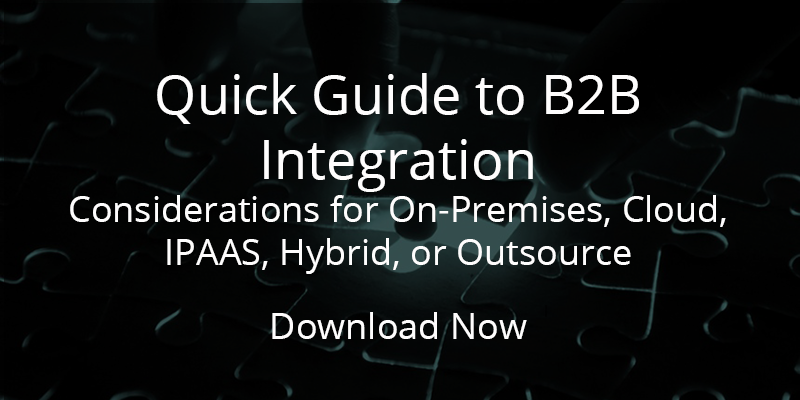
If you’re strategizing with your LOB colleagues and decision makers at your company about how to level up your B2B integration capabilities, you’re not alone.
In fact, given how swiftly the pandemic has exposed vulnerabilities and limitations in legacy systems, it would be dangerous not to be already identifying the gaps and blind spots in your integration infrastructure. Coming out of the pandemic—and we will, eventually— the winners will be those companies who can shapeshift quickly to meet new demands and serve new needs.
We’ve all heard and been inspired by stories of the furniture maker who was able to pivot to manufacturing PPE and cut weeks or months out of the onboarding dance with new suppliers and customers thanks in part to modern B2B integration tools.
Right now, the question companies who plan to be around and prepared for the next Black Swan event should be asking themselves is do they have the B2B integration capacity to execute new business strategies. If the answer is no, the next question to tackle is which integration model to choose.
At one time, on-premises was the only delivery model available. Your options have expanded as B2B integration solutions evolved into more than X12 or EDIFACT EDI, and integration solutions served and supported over the internet offer several additional options.
One size doesn’t fit all and it’s critical your choices aligns with your firm’s technical capabilities, business strategy and growth targets. For a refresher on the four integration models, check out our first article in this series.
In this post, we’ll dive into the on-premises B2B integration model and discuss the seven reasons you might want to choose it over the other models.
On-premises as a Differentiator
In our own work with clients during the lockdown of the economy following the outbreak of Covid-19, we saw how the businesses who had control of their integration environment and resources were able to pivot more quickly than those with some other integration methods, say outsourcing, where shared labor might have lengthened your pivot timelines and limited pivot capabilities.
Still, it’s fair to ask—and your stakeholders will-- why would anyone want to choose on-premises deployments, which seem to some to be mired in the past? For organizations who view their digital connectivity as a competitive advantage, the on-premises model offers two compelling, related benefits:
- Responsiveness
- Ability to accommodate any integration request
Cloud, hybrid, and outsourced solutions— which is to say off-premises—have advantages we’ll explore in subsequent blogs, but each presents varying degrees of difficulty to customize without costly and time-consuming development workarounds. That could be risky if you’re onboarding a new customer with unique onboarding requirements or a complicated workflow.
Let’s say that sales for non-toxic insect repellent your company makes have grown exponentially in response to strong word of mouth— so much that Walmart has agreed to stock it. It’s a game-changing opportunity for your company to expand beyond its regional bait shop and state park camp store base, and now the CEO wants to know if IT can meet the retailer’s requirements and timeline.
In this situation, you wouldn’t want to leave the details of onboarding, systems configuration, and testing to an off-premises solution where tech support assigned to your account may not share your company’s priorities or sense of urgency—especially if and when last-minute glitches pop up to threaten the timeline and trigger the SLA penalties.
A Better Customer Experience
Another point in favor of on-premises B2B integration deployments is a better customer experience. This claim is based upon the integration and customization capabilities of on-premises software.
An on-premises B2B integration strategy gives you complete control over the customer experience, ensuring the data stream and access points in your integration infrastructure are always available to your customers. Choosing a hosted or cloud software provider means you yield your autonomy over your software— and customer relationship—to a third-party.
If the outsourcing vendor has a problem you’re at the mercy of outside support resources. Worse, you could find out about it too late to do anything but issues apologies and wait for a resolution and chargeback. Bottom line, because on-premises deployment uses your network, you have visibility into what’s— or what’s not— happening. You’re not dependent upon someone else’s network for the integration solution to work.
Ease of Integration
Just as some cloud-based and outsourced B2B integration options are not easily customized, when it comes to their ability to integrate with your existing data sources or partner requirements, these options can fall short on this front.
It’s true that cloud and outsourced B2B integration models can integrate with many data sources and ERPs out of the box, but you cannot customize additional or unsupported sources without a great deal of time, effort, and money.
That’s problematic, given how integrating with a variety of current and future, yet unknown data sources is a must-have for many organizations-- especially if those other data sources are mission-critical.
Furthermore, because the systems are within the same infrastructure with on-premises, sourcing and integrating data is easier. Having ERP, data transformation, and integrators all in the same place makes on-premises B2B integration solutions easier, faster, and cheaper to customize.
Compliance Regulations
Compliance to government and industry regulations also affects the suitability of a B2B integration option. For some companies, complying with government and industry regulations means that on-premises B2B integration solutions are the best option.
Deploying a B2B integration solution on-premises places a higher security burden upon a company. It means that its employees bear responsibility for keeping data safe. While that higher security burden requires greater staffing resources, it also gives you greater control over your data.
You Control Your Data
Besides alleviating compliance concerns, on-premises deployment gives you greater control over your data. For some organizations, controlling their data is an end unto itself.
For example, you might need data control for legal reasons. Direct access to and control over your data makes it more convenient and efficient for running analytics and reporting. At the same time, you’re able to dictate and manage data retention, access, and security policy.
That matters because cloud and outsourced vendors do not always keep data forever. If you choose a cloud or outsourced vendor, you’ll want to negotiate the retention you need which may come at a price, or have a workflow set up to download and back up your business-critical information or risk its deletion.
You Control Your Staff
An on-premises B2B integration calls for a team of dedicated integration professionals who will maintain the software, servers, and develop the integrations with your partners and systems. While outsourcing can be a cost-effective solution for many, we'd advise anyone considering this route weigh the implications.
When you outsource, you give up control over who will be maintaining your software and performing the integrations. A cloud provider model may allow you to bring your own personnel but will have its own employees for some tasks where they will split their time between you and other clients.
This means you might not have access to these resources when you need them the most.
That matters because it’s during moments of downtime, a major experience glitch, or a security breach when you’re most at risk of serious business damage in reputation and financial terms.
Even if you use a team of contracted integration professionals to maintain your on-premises B2B integration solution, you still manage them and manage your risk by comparison to some other integration models.
Also, if an integration solutions partner isn't meeting expectations, you're free to make a change while your on-premises integration infrastructure remains intact.
With an outsourced model and some cloud providers, you don’t have that flexibility.
On-premises Software Does Not Always Cost More
When comparing the costs of on-premises B2B integration software against the other options, you’ll want to factor in the cost of potential lost business, inability to make fast pivots, your place in the queue when there’s an outage or an issue, and last but not least, lack of a competitive edge for your brand.
While admittedly these are soft costs, many of our clients have been lured by the seemingly low cost of off-premises solutions, only to return to the on-premises or hybrid model after discovering the downside of relinquishing control of their B2B integration software, infrastructure, and integrators to a third parties without sufficient skin in the game.
At the same time, an on-premises B2B integration can require a large upfront investment.
In this model, you are purchasing software, servers, and you will need the requisite staff in house (or motivated and skilled contractors) to maintain it. You’ll have upgrade costs unlike compared to some off-premises solutions and the onus is on you to carry out upgrades—all of which can be time-consuming and redirect your staff efforts.
Bottom line, determining which integration deployment model makes the most sense for you involves more than which is cheapest up front. If the model you choose doesn’t align with your strategic plans, or it fails to meet the requirements of the customers and partners you value most, it doesn’t matter how inexpensive it seems.
If it will impede your growth or lead to lost business, you can’t afford it.
About Remedi
Remedi Electronic Commerce Group helps companies save time and money, provide a better customer experience, and quickly respond to new opportunities using integration and B2B ecommerce solutions built for a digitally driven economy.



